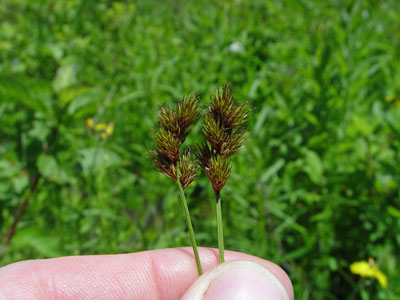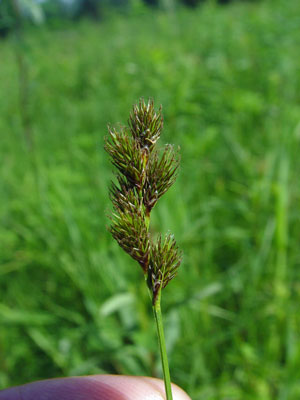DACF Home → Bureaus & Programs → Maine Natural Areas Program → Communities, Plants, and Animals → Rare Plants → Carex oronensis
Carex oronensis Fern.

Orono Sedge
- State Rank: S3
- Global Rank: G3
- State Status: Threatened
Habitat: Fields, meadows and clearings. [Old field/roadside (non-forested, wetland or upland)]
Range: Endemic to Maine (occurring nowhere else), known only from the Penobscot River valley.
Aids to Identification: Members of this genus can be difficult to identify without careful examination of microscopic features and knowledge of general groups of species. C. oronensis is one of the section Ovales (within the genus), a group distinguished by its dense roundish heads of fruits and perigynia (the inflated sacs that enclose the ovary) with thin, winged margins. Orono sedge grows in loose clumps, producing sharply angled stems, 0.5-1 m tall. The leaves are much shorter than the stem, the principal leaf blades 3-5 mm wide. It is most similar to and may occur with C. ovalis, which also has floral scales as long as the perigynia. The two species can be distinguished by the narrower perigynia of C. oronensis and by minute papillage at the summit of leaf sheath (C. ovalis has smooth sheaths).

Ecological characteristics: Carex oronensis occurs with other species in the genus Carex at all known sites. Growth and reproduction may depend on light availability, with the largest populations growing in open sun. Plants growing in the shadiest sites tend to be few, small, and with few reproductive culms. Carex oronensis tends to grow in highly disturbed sites, including roadsides. The largest populations are in hayfields. The perigynium, which is shaped like a small boat, suggests that dispersal by water is possible. It has also been speculated that small teeth on the edges of the perigynium aid in dispersal by animals, and that transport of hay may have contributed to its dispersal.
Phenology: Flowers in June; fruiting July - August.
Family: Cyperaceae
Synonyms: None noted.
Known Distribution in Maine: This rare plant has been documented from a total of 40 town(s) in the following county(ies): Aroostook, Hancock, Penobscot, Piscataquis, Somerset, Waldo.
Reason(s) for rarity: Unknown. Apparently suitable habitat adjacent to known occurrences is not colonized by C. oronensis.
Conservation considerations: Changes in land use (e.g. conversion by development) and succession by woody species appear to be the most obvious threats to Carex oronensis.Because this plant typically occurs along roadsides or in hayfields, populations are vulnerable to development or road maintenance, but may be able to be worked around. The plants cannot tolerate competition from woody species, so annual mowing can help maintain populations.